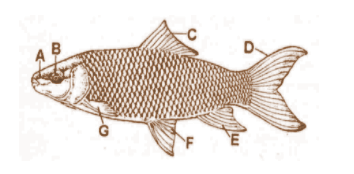
The diagram of Labeo is given. Identify the parts labelled as A, B, C, D, E, F and G.

A. A - Nostril B – eye B - Dorsal fin D - Caudal fin E - Anal fin F - Pelvic fin G - Pectorial fin
B. A - Nostril B – eye B- Dorsal fin D - Caudal fin E - Pectorial fin F - Anal fin G - Pelvic fin
C. A - Nostril B – eye B - Dorsal fin D - Anal fin E - Caudal fin F - Pectorial fin G - Pelvic fin
D. A - Nostril B – eye B - Anal fin D - Caudal fin E - Dorsal fin F - Pectorial fin G - Pelvic fin

Answer
474.3k+ views
Hint: Labeo rohita is commonly known as the “Rohu” fish. Bony fishes have paired pectoral and pelvic fins. They also possess dorsal, anal, and caudal fins. Bony fishes also possess an operculum.
Complete answer:
Labeo rohita or “Rohu” is a freshwater bony fish which is found in lakes, ponds, and rivers. The body of the fish is spindle-shaped and laterally flattened. These are usually dark greenish-black in colour. A Labeo has:
(A) It is the nostrils on the snout.
(B) It is a pair of lateral eyes on both sides.
(C) It is the dorsal fin which is located at the back of Labeo.
(D) The caudal fin is the tail fin which is located at the end of the caudal peduncle and it is used for propulsion.
(E) It is an unpaired anal fin that is located on the underside of the fish posterior to the anus.
(F) It is a pair of fins which is positioned on the underside of the body of the fish's pelvic fin.
(G) It is a pair of fins situated one on each side of the fish present just behind the gills are pectoral fins.
Hence, the correct answer is option A.
Additional information: Scientific classification of Labeo rohita is given below:
Note: Labeo is a genus of carps belonging to the family Cyprinidae and the subfamily Labeoninae. They belong to the group of fishes known as Osteichthyes. They are mainly found in freshwater habitats like lakes and rivers usually in the tropics and subtropics of Africa and Asia.
Complete answer:
Labeo rohita or “Rohu” is a freshwater bony fish which is found in lakes, ponds, and rivers. The body of the fish is spindle-shaped and laterally flattened. These are usually dark greenish-black in colour. A Labeo has:
(A) It is the nostrils on the snout.
(B) It is a pair of lateral eyes on both sides.
(C) It is the dorsal fin which is located at the back of Labeo.
(D) The caudal fin is the tail fin which is located at the end of the caudal peduncle and it is used for propulsion.
(E) It is an unpaired anal fin that is located on the underside of the fish posterior to the anus.
(F) It is a pair of fins which is positioned on the underside of the body of the fish's pelvic fin.
(G) It is a pair of fins situated one on each side of the fish present just behind the gills are pectoral fins.
Hence, the correct answer is option A.
Additional information: Scientific classification of Labeo rohita is given below:
| Kingdom | Animalia |
| Phylum | Chordata |
| Class | Actinopterygii |
| Order | Cypriniformes |
| Family | Cyprinidae |
| Subfamily | Labeoninae |
| Genus | Labeo |
Note: Labeo is a genus of carps belonging to the family Cyprinidae and the subfamily Labeoninae. They belong to the group of fishes known as Osteichthyes. They are mainly found in freshwater habitats like lakes and rivers usually in the tropics and subtropics of Africa and Asia.
Latest Vedantu courses for you
Grade 10 | MAHARASHTRABOARD | SCHOOL | English
Vedantu 10 Maharashtra Pro Lite (2025-26)
School Full course for MAHARASHTRABOARD students
₹31,500 per year
Recently Updated Pages
Express the following as a fraction and simplify a class 7 maths CBSE

The length and width of a rectangle are in ratio of class 7 maths CBSE

The ratio of the income to the expenditure of a family class 7 maths CBSE

How do you write 025 million in scientific notatio class 7 maths CBSE

How do you convert 295 meters per second to kilometers class 7 maths CBSE

Write the following in Roman numerals 25819 class 7 maths CBSE

Trending doubts
State and prove Bernoullis theorem class 11 physics CBSE

What are Quantum numbers Explain the quantum number class 11 chemistry CBSE

Write the differences between monocot plants and dicot class 11 biology CBSE

1 ton equals to A 100 kg B 1000 kg C 10 kg D 10000 class 11 physics CBSE

State the laws of reflection of light

In northern hemisphere 21st March is called as A Vernal class 11 social science CBSE




